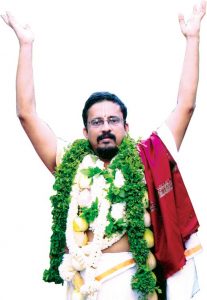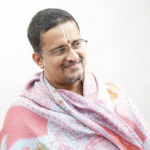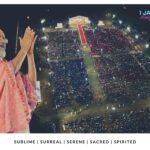 Attaining moksha is considered to be the highest goal of life and our scriptures prescribe various ways to reach that supreme goal. The same scriptures also emphasize that in this Kali Yuga, there is only one possible route to the highest goal: Nama sankirtan. The greatness of Nama sankirtan and more specifically the Rama Nama is the essential message that is emphasized throughout Sant Tulsidas’ Ramcharitamanas, the great Ramayana text that is recited and worshipped across the world.
Attaining moksha is considered to be the highest goal of life and our scriptures prescribe various ways to reach that supreme goal. The same scriptures also emphasize that in this Kali Yuga, there is only one possible route to the highest goal: Nama sankirtan. The greatness of Nama sankirtan and more specifically the Rama Nama is the essential message that is emphasized throughout Sant Tulsidas’ Ramcharitamanas, the great Ramayana text that is recited and worshipped across the world.
In Bala Kanda, Tulasidasji starts by offering his obeisance to the many gods and saints. Among these holy deities, Tulasidasji also prays to Lord Rama’s Name: “Bandau nama rama raghubara ko”. Tulasidasji continues to glorify the holy name of Lord Rama by saying “Mahamantra joi japata mahesu, kasi mukuti hetu upadesu”. He says Rama Nama is used by Lord Shiva in Kashi to give moksha to the departed souls. Indeed Lord Shiva himself chants the name of Lord Rama continuously. Furthermore, it is said “Mahima jasu jana ganarau, prathama pujiata nama prabhau”. The glory of the Name is known to Lord Ganesha as well. He is prayed to first by the influence of the Name alone.
In one particularly powerful metaphor, Tulasidasji declares, “Rama nama narakesari, kanakakasipu kalikala, japaka jana prahalada jimi paliji dali surasala”. The comparison here is of Rama Nama to Lord Narasimha, an Avatara of Lord Vishnu. The Kali age represents the demon Hiranyakashipu while we, the chanters of the Name, represent Bhaktaraja Prahalada. This shows that the Lord’s Name is capable of destroying all of our obstacles as well as of providing us protection while crossing the ocean of samsara in this Kali Yuga.
But the great saint goes one step further to convey the importance of Nama by making it greater than Lord Rama himself.
“Rama eka tapasa tiya tari, nama koti khala kumati sudhari. Rama bhalu kapi kataku batora, setu hetu sramu kinha na thora. Namu leta bhavasimdhu sukhahi, karahu bicaru sujana mana mahi.”
Lord Rama gave salvation to one Ahalya while the Nama gives salvation to the millions of sinners who chant it. By the prowess of Lord Rama, the monkey army built a bridge to cross the ocean to Lanka. However by the prowess of Lord Rama’s Name, the entire ocean of samsara is bridged for all the downtrodden souls of the world.
Even after all these examples, Tulasidasji feels he has not done the Nama enough glory and concedes by saying “kahau kaha lagi nama barai, ramu na sakahi nama guna gahi”. What words are there to depict the glory of the Lord’s name, if Lord Rama himself cannot adequately glorify it?
The Ramayana story itself is testimony to the effects of chanting the Name. On his deathbed, King Dasaratha chants Rama Nama and attains Liberation. In Sundara Kanda, Hanuman starts his voyage over the ocean by repeatedly chanting Rama Nama. Later in the Sundara Kanda, Vibhishana’s Rama Nama chanting helps Hanuman recognize him as the Lord’s devotee. And before beginning the war in Lanka, the whole monkey army of Rama shouts out “Jai Rama”, which results in their victory. All direct proof that chanting the Name in our lives will make us successful as well.
The Ramacharitmanas is simply a collection of the lilas and Names of the Lord. That is why Tulasidasji can declare that “Rama katha sundara karatari, sansay bihag udavanahari”. The story of Lord Ramachandra is like the clapping of the hands that scares away the birds that represent life’s problems!






